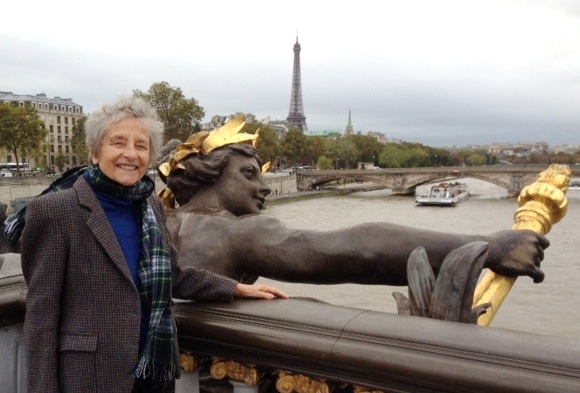
The Georges Braque retrospective in Paris – the first in 40 years – just closed its doors after four months at the Grand Palais. Braque is best known for being one of the creators of cubism. But it would be an error to overlook the rest of his creative life, which was in constant metamorphosis from “Fauvism” at age 24 to his art studio and magnificent birds series from the 1930s onwards. He was one of those rare artists to be recognized during his lifetime since honors were lavished on him.
Georges Braque (1882-1963) was a tall, handsome man with a quiet manner. Instead of joining his father as a painting contractor, he left Normandy and moved to Paris to study art. Soon he joins the Fauves (Matisse, Derain, Vlaminck) and his paintings at l’Estaque, or La Ciotat, on the Mediterranean, are an orgy of colors.
Then, after a two-year period, with the same apparent ease, he absorbed the geometrization of nature approach that Cézanne was the first to introduce. The old master had died just one year earlier. Braque turned houses and vegetation into stylized shapes, devoid of any detail. His colors are muted.
In 1907, Braque went to the Bateau Lavoir studio of Picasso in Montmartre. Since 1905, Picasso (two years his junior) had been feverishly working on the “Demoiselles d’Avignon.” Braque sees the preparatory studies Picasso had done, and is stunned.
From that time until the beginning of the Great War, a relationship – unique in the history of art – is formed between the two artists, based on mutual stimulation without any trace of rivalry. They were like mountain climbers roped together, to use Braque’s own words. Braque’s “Le Grand Nu” of a heavy set woman, with a distorted body, the face like a mask, shows the same understanding of African art that Picasso imbued.
In 1908, art critic Louis Vauxelles commented that Braque’s painting were reduced to cubes — thus, the word “cubism” was born. Braque and Picasso were about to create the most important aesthetic revolution of the 20th century.
In the next few years, cubism evolved through several phases: “analytic” with the de-multiplication of the object into facets, absent of perspective. A second phase, called “hermetic”, followed. It is austere, to the point of being illegible, with colors reduced to camayeux (monochromes) shades of grey and ochre. During the final “analytic” phase, the artist introduced clues to help the onlooker: letters from wine bottle labels or newspapers, or parts from a piano, guitar or mandolin (Braque had a passion for music.)
During this period, Braque and Picasso were also to invent totally new techniques to be emulated by many other artists: first the method of “collage ” using a variety of materials like sand, metal shaving, ground glass or dirt. In his key painting titled, “Compotier, Bouteille et Verre, “(fruit dish, bottle and glass) of August 1912, he introduced the method of “papiers collés” (glued papers) serving as “trompe-l’oeil.”
In 1914, Braque is called to the European front. In May 1915, he is seriously wounded in the Artois battle and undergoes brain surgery. After coming out of his “trou noir” (black hole), he begins a long convalescence. Not surprisingly, given his personality, he feels no bitterness, nor anger .
He returned again to cubism, but this time his paintings are vibrant with colors and, in spite of their abstraction, easier to read.
In the 1930s, his series of still life paintings in his art studio setting is so complex as to be called “studio landscapes.” A charming chaos seem to lift fruits and objects and pile them on the ubiquitous “guéridon” (round table.) An exuberant humor replaced the austerity of his pre-war cubism. American collectors, like MOMA or the Phillips gallery, are enthusiastic about his new works.
In the mid 1950s, the artists introduces a new theme : a bird floating above the apparent disorder of the studio. In “Nid dans le Feuillage” (Nest in the foliage), the bird flies over an eerie mountainous landscape toward a nest lit in a frigid light. The emptiness of his very last painting,”Sarcleuse,” is overpowering. Under a black sky, golden wheat undulates in the breeze. The metal wreck of the “sarcleuse” (agricultural machine) left on the beach is a final message of human activity.
 About the author: Nicole Prévost Logan divides her time between Essex and Paris, spending summers in the former and winters in the latter. She will write a regular column for us from her Paris home where her topics will include politics, economy, social unrest — mostly in France — but also in other European countries. She also will cover a variety of art exhibits and the performing arts in Europe. Logan is the author of ‘Forever on the Road: A Franco-American Family’s Thirty Years in the Foreign Service,’ an autobiography of her life as the wife of an overseas diplomat, who lived in 10 foreign countries on three continents. Her experiences during her foreign service life included being in Lebanon when civil war erupted, excavating a medieval city in Moscow and spending a week under house arrest in Guinea.
About the author: Nicole Prévost Logan divides her time between Essex and Paris, spending summers in the former and winters in the latter. She will write a regular column for us from her Paris home where her topics will include politics, economy, social unrest — mostly in France — but also in other European countries. She also will cover a variety of art exhibits and the performing arts in Europe. Logan is the author of ‘Forever on the Road: A Franco-American Family’s Thirty Years in the Foreign Service,’ an autobiography of her life as the wife of an overseas diplomat, who lived in 10 foreign countries on three continents. Her experiences during her foreign service life included being in Lebanon when civil war erupted, excavating a medieval city in Moscow and spending a week under house arrest in Guinea.